The Major Cycles and Life’s Octaves
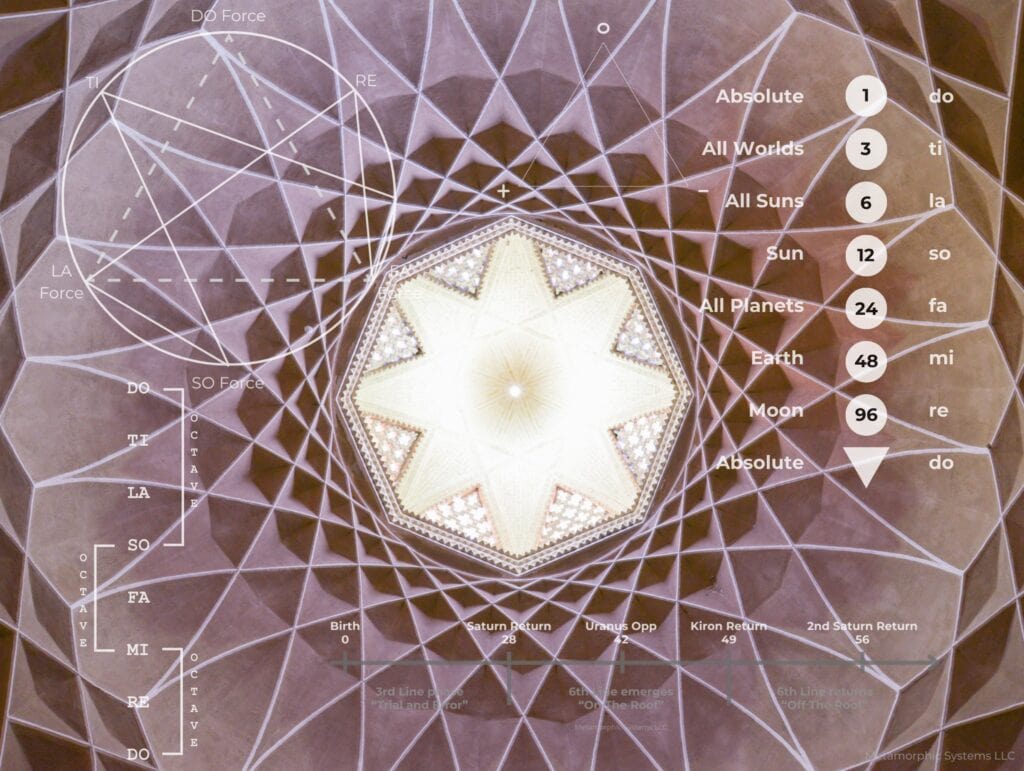
How the major astrological cycles in Human Design, the Laws of Seven and Three, and Gurdjieff’s Cosmology Reveal a Harmonic Map of Human Development
The principle of “as above, so below” suggests that human life reflects cosmic patterns — a concept central to astrology, alchemy, Taoism, and esoteric traditions that attempt to understand and fully embody what it means to be human.
In Taoism, personal cultivation aligns with the seasons and celestial movements. The seasonal cycle parallels human development: spring represents birth, summer signifies active growth, autumn indicates maturity, and winter reflects introspection. We see this cycle of development mirrored in the movement through the 12 signs of the astrological zodiac. Even from a more scientific perspective, solar activity, such as sunspots and solar flares, has been linked to periods of innovation and shifts in collective consciousness. Lunar phases, in turn, influence ocean tides and emotional intensity. Structures like those seen in sacred geometry, Fibonacci spirals, and DNA helices highlight consistent mathematical patterns in both individual organisms and the universe as a whole.
Human Design provides a mechanical perspective on this principle of “as above, so below”, suggesting that neutrinos — tiny particles emitted by stars — pass through planets, imprinting us with patterns that influence our perception and growth. This article explores how Human Design’s major planetary cycles — Saturn Return, Uranus Opposition, and Chiron Return — align with G.I. Gurdjieff’s octave-based cosmology. While there may be inaccuracies, the article attempts to introduce the main concepts in broad strokes, with the understanding that the details are more complex than can be explained in this context.
The Octave Structure: The Law of Seven
In Fourth Way cosmology, two foundational “Laws of World Creation and World Maintenance” govern all processes: the Law of Three and the Law of Seven. In my previous article, “Beyond Yes and No: The Third Force,” I explored the Law of Three, which posits that creation occurs through three distinct forces. This article focuses on the Law of Seven (also known as the Law of Octaves), which describes how natural processes unfold in a seven-step sequence.
The musical scale expresses this law and serves as a useful model: Do–Re–Mi–Fa–Sol–La–Ti–Do. Each note in the octave corresponds to a diatonic ratio — 1/4, 1/3, 1/2, 2/3, and 7/8 — representing measurable vibrational steps.
The process begins with a new DO and continues upward until it reaches MI and TI, where development falters. MI and TI represent vibrational discontinuities — unlike the whole steps between other notes, MI–FA and TI–DO are half steps, where momentum weakens.
Progress stalls at these intervals without additional energy, like a cyclist facing a steep hill who must shift gears or exert extra force to continue.
The Law of Three and the Function of Shock
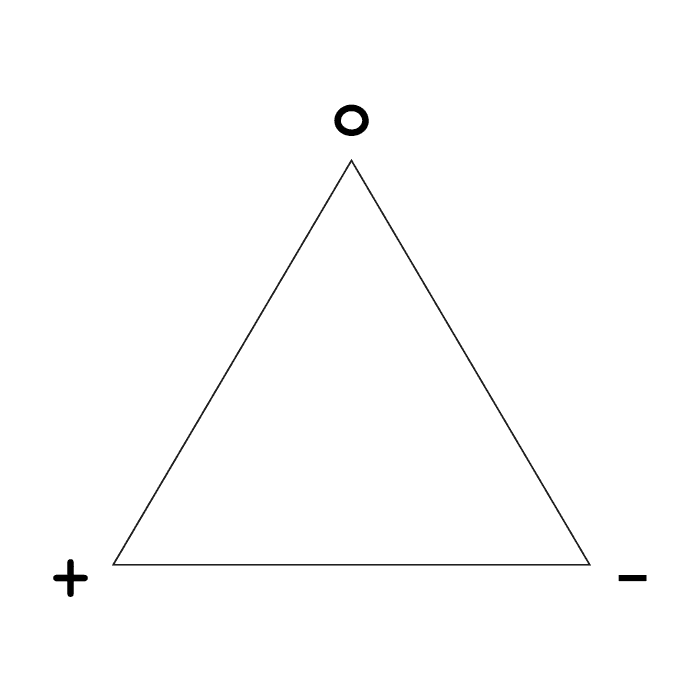
The Law of Seven operates in concert with the Law of Three, which describes how the Affirming, Denying, and Reconciling forces interact at every stage of development. Development breaks down at MI–FA and TI–DO intervals because the initial Affirming force has reached its limit. These intervals mark a structural impasse between the first two forces, where momentum alone cannot sustain the process.
To continue, the third force — the Reconciling Force, a neutralizing energy that resolves tension between opposing forces — must enter, like a biking competitor knowing what it takes to keep their pace and the race. In Fourth Way language, this necessary infusion of energy, insight, or influence that allows the process to resume is called a “shock”. Without it, development is deflected, stalled, or lost.
The initial Affirming force meets resistance at FA and LA, which could appear as friction, entropy, or inner conflict. These are natural moments of instability, where shock intervention becomes essential. The shock allows for the Reconciling Force to enter, making transformation possible.
In the Gurdjieff Work, this ongoing engagement with life’s interruptions is known as “conscious labor and intentional suffering.” Shocks are inevitable and part of the cosmic order and may arise externally through crises or changes, or internally through insights and inner tension. Transformation depends not on the shock itself, but on how we meet it. When received unconsciously or suppressed, a shock may derail the process. However, when met intentionally, with presence and awareness, it becomes the condition through which development can proceed. In this sense, the cosmic laws reveal a structure of progression and illuminate the places where breakdowns and breakthroughs are possible.
Mapping This Structure: The Diatonic Enneagram

As one of my primary Fourth Way teachers, Russell A. Smith illustrates in his groundbreaking exploration of the cosmic laws, Gurdjieff: Cosmic Secrets, the Diatonic Enneagram — a diagram using musical ratios to map the precise vibrational points where transformation requires external energy — reveals how these vibrational intervals are embedded in the process. It shows how the Denying Force becomes especially active at FA and LA, aligning with the MI–FA and TI–DO intervals.
Unlike the more well-known Symbolic Enneagram, which portrays the universal pattern of transformation through geometry and the Law of Three, the Diatonic Enneagram maps the mechanics of octave movement using exact musical ratios. It is not a metaphor but a structural blueprint of how transformation occurs — and where it fails without timely intervention.
While the concept of octaves as fundamental developmental structures traces back to Gurdjieff and was explored by Ouspensky and his student, Rodney Collin, it was Russell A. Smith who rigorously formalized the Diatonic Enneagram using precise Pythagorean ratios. He mapped each note of the octave to its vibrational proportion (e.g., 1/4, 1/3, 1/2, etc.). He used this framework to chart exact shock points, reveal structural resistance at MI–FA and TI–DO, and demonstrate why shock must be initiated at MI or SO, not at the point of breakdown itself. Smith’s work turned a symbolic teaching into a law-conformable schematic: a repeatable, mathematical model of transformation used for both cosmological mapping and inner development.
Life progresses through layered octaves — each stage nested within a larger one, as Russell Smith explains in Gurdjieff: Cosmic Secrets. Every process and octave, whether a day, decade, or lifespan, follows the Law of Seven, encountering MI–FA and TI–DO, where progress slows. This pattern is evident throughout nature — in the periodic table, planetary orbits, and cultural myths — illustrating a structured process of change.
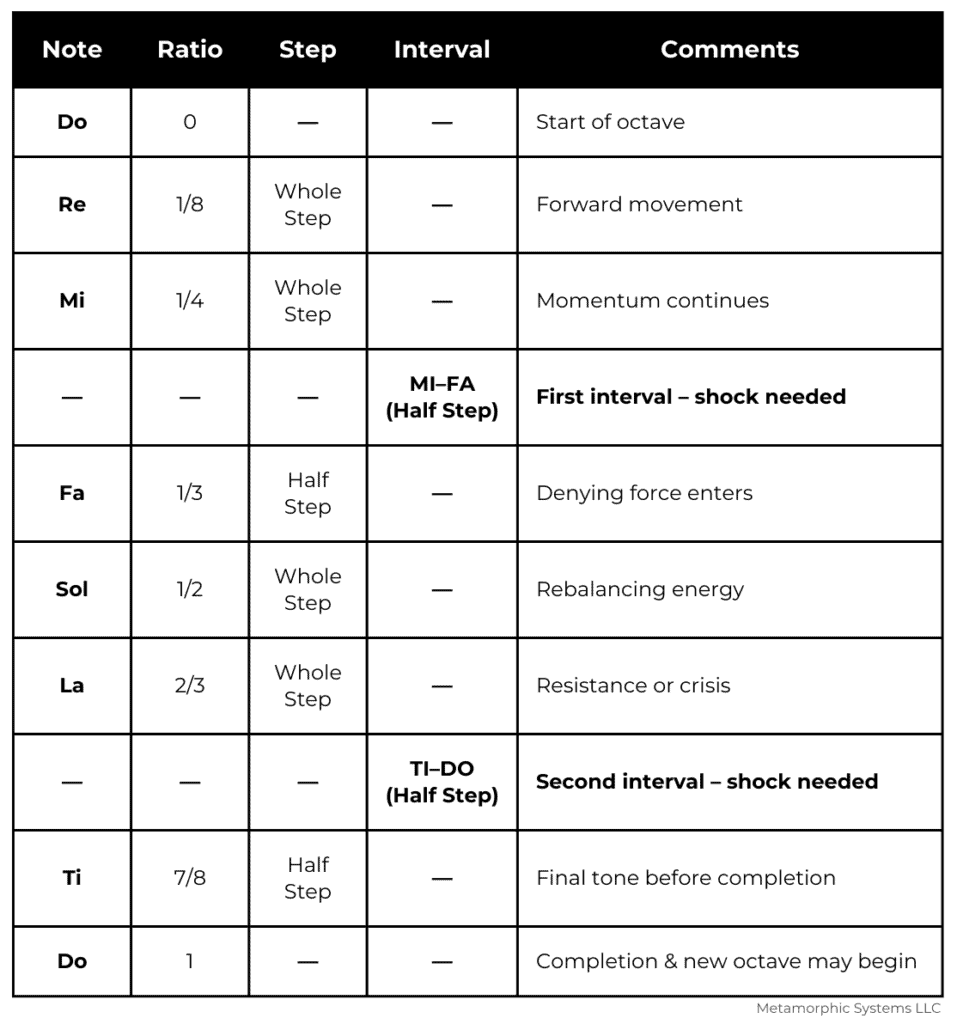
The Ray of Creation and the Density of Experience
Gurdjieff’s “Ray of Creation,” first published by P.D. Ouspensky in his seminal book, In Search of the Miraculous, outlines how vibration descends from the Absolute to the Moon through increasing levels of density — a framework of cosmic structure. Each level introduces more governing laws that reduce freedom, much like a system that becomes more complex as it expands.
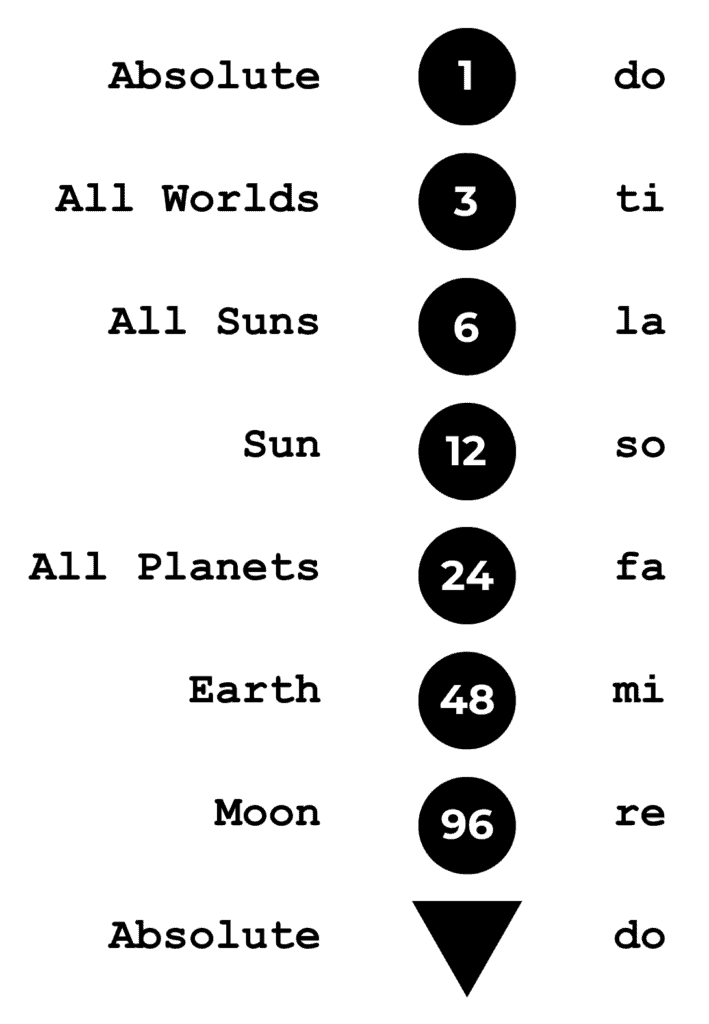
The hierarchy is as follows:
- Absolute: 1 law (do)
- All Worlds: 3 laws (ti)
- All Suns: 6 laws (la)
- Sun: 12 laws (so)
- All Planets: 24 laws (fa)
- Earth: 48 laws (mi)
- Moon: 96 laws (re)
Humans live under 48 laws on Earth, but through conscious effort, we can elevate ourselves toward fewer laws and greater freedom.
This model is a simple illustration of how energy moves through octave-like stages across the universe and can serve as a reference point for both cosmic order and personal development.
Mapping the Human Life Cycle to the Octave
Gurdjieff and later Russell Smith stated clearly and repeatedly that “The Law of Seven and Law of Three apply to any totality, any whole phenomenon, any process from all to nothing or nothing to all.” Some processes that Smith explored in Gurdjieff: Cosmic Secrets include atomic decay, planetary formation, biological evolution, and the structure of consciousness itself.
As Rodney Collin first observed in his book The Theory of Celestial Influence, the same cosmic laws that govern planetary orbits also shape human development. Building on his pioneering explorations, I propose mapping the 84‑year Uranian human life cycle put forth in Human Design by applying the diatonic octave (1/4, 1/3, 1/2, 2/3, and 7/8), creating a harmonic map of human growth.
The following key astrological milestones will give substance to the model:
- The Saturn Return, typically occurring around age 29, marks a transitional phase during which established external roles and responsibilities are critically reassessed.
- The Uranus Opposition, often near age 42, signifies a period of sudden disruption that challenges entrenched patterns and calls for renewed independence.
- The Chiron Return, typically occurring around age 50, marks a pivotal moment of integration, where past wounds are confronted and transformed.
- The Second Saturn Return, typically occurring around age 58, completes the second Saturn cycle and is a time of solidification and refinement.
The average orbital periods of the relevant planets are as follows:
- Saturn: ~29.46 years
- Chiron: ~50.3 – 50.7 years
- Uranus: ~84 years
If we map an octave from 0 to 84 using the diatonic ratios, we see the following:
- DO (0) = 0 (Birth)
- RE (1/8) = 10.5
- MI (1/4) = 21
- FA (1/3) = 28 (Saturn Return)
- SO (1/2) = 42 (Uranus Opposition)
- — Midpoint = 49 (Chiron Return)
- LA (2/3) = 56 (Second Saturn Return)
- TI (7/8) = 73.5
- DO (1) = 84 (Uranus Return)
While the planetary returns don’t align precisely with the diatonic ratios, they are very close, and the Uranus Opposition at 42 is a striking resonance. The Saturn Returns and Chiron Return each occur one year after the corresponding notes in the octave (perhaps representing the orb of the planetary transit).
We can also see the half-step discontinuities in the process at MI–FA and TI–DO, where the natural momentum begins to falter. According to the Law of Seven, these points require a consciously integrated shock to continue the developmental process.
From our understanding of the octave structure related to the Law of Three, it follows that these shocks or interventions must be introduced at earlier stages (typically near MI in the first sub‑octave and at SO in the second) to propel growth through otherwise resistant intervals.
Shocks can take various forms, such as:
- A significant life event, such as graduation, divorce, or a career change, that shifts one’s trajectory
- A health crisis that forces a re-evaluation of priorities
- An inner realization that fundamentally changes one’s perspective
- A psychological or spiritual challenge that disrupts outdated patterns
- A person in our lives who suddenly becomes prominent or influential
Interestingly, on this octave, the only major cycle that aligns precisely with a note (SO) and brings a shock is the Uranus Opposition, which is often described as a time of unexpected changes and potential disruptions.
Oscillations and Nested Arcs of Development
While the Ray of Creation and the octave of an 84-year human life cycle provide elegant models for cosmic order and personal growth, life does not simply unfold in a straight line. It unfolds through nested octaves — smaller arcs embedded within the greater life process, each with its own rhythm, structure, and function. These arcs follow a recurring vibrational pattern known as an oscillation.
In Russell A. Smith’s octave-based cosmology, an oscillation refers to the reciprocal vibrational movement between two poles of an interval — a span that carries the potential for transformation. Each oscillation begins with momentum, breaks down at a point of tension, and continues only through a shock that reconciles opposing forces. Smith formalized these structures in his concept of the Universal Cosmic Weave, a framework mapping nested vibrational patterns across cosmic and personal development, identifying three major oscillations in the full human life octave.

These oscillations mirror both the structural intervals of the scale and the functional stages of development in Gurdjieff’s three-story model, as further articulated by Russell Smith: the Instinctive and Moving Centers form the lower story, the Emotional and Intellectual Centers form the middle story, and the Higher Emotional and Higher Intellectual Centers form the upper story. Each oscillation connects a lower center to its higher counterpart, creating a bridge that must be consciously traversed if transformation is to occur.
When we apply this to the 84-year life octave using diatonic ratios, a coherent pattern emerges loosely mirroring the tri-partite life process modeled by the 6th Line Profile:
1. First Oscillation — DO to MI (~0 – 21 years)
Centers: Instinctive ↔ Moving
Life Function: Biological and mechanical development
Vibrational Role: The initial arc of physical formation, habit formation, and survival conditioning.
Developmental Themes:
- Driven by parental and environmental influence (momentum phase)
- Early education, socialization, and identity structuring
- Shock required near MI (~21): a catalyst for individuation and self-direction
This arc generally corresponds to the first phase of the 6th Line Profile: the 3rd Line process of trial, error, and immersion. The first Saturn Return near age 28 signifies the closure of this arc and a potential transition into the next.
DO–MI spans birth to early adulthood. It is a period of passive, mechanical development in which essence is shaped by external conditioning — family, culture, education. Though rich in growth from the outside, it is largely devoid of inner choice. We need a shock at MI, around the age of 21, to get us past the following note FA at 28 years.
2. Second Oscillation — FA to LA (~28 – 56 years)
Centers: Emotional ↔ Higher Emotional
Life Function: Emotional maturity and meaning-making
Vibrational Role: The central oscillation of life — the primary arena for psychological and relational transformation
Developmental Themes:
- Begins at FA (~28) (Saturn Return), often with disillusionment and reassessment
- Includes the Uranus Opposition (~42) (SO) and Chiron Return (~49)
- Culminates at LA (~56) (Second Saturn Return), often marking a new orientation toward purpose and clarity
This oscillation aligns with the “Roof Phase” of the 6th Line Profile: a withdrawal for observation, integration, and deep emotional and existential reorientation. From roughly age 28 to 56, the octave moves through the tones of FA, SO, and LA — a long central stretch of life where one is often challenged to reconcile the outer engagements with inner alignment. FA marks the transition into adulthood proper, a time of responsibility, choice, and impact. It is the first tone after the MI–FA shock (often a crisis of direction in the late 20s), and begins the maturation of essence through experience. In SO (approximately 44.5), individuals are frequently at the peak of their outer success or productivity, but also face disillusionment, burnout, or a sense of something missing.
This phase deepens the tension between personality and essence. Life transitions — such as divorce, career change, or illness — often act as shocks that expose the limits of living out of alignment with one’s true self and trajectory. If used consciously, these experiences create friction that refines being. By LA (around age 56), the outer arc begins to bend inward. For those on a path of self-observation or spiritual practice, LA can be a quiet but powerful moment of readiness—a sense that the real work is now inward, and the deeper octave is calling.
The LA–TI stage marks a profound phase of integration, distillation, and interiorization. After decades of outer activity — career, relationships, ambitions — this period is less about acquiring and more about synthesizing. It’s a turning inward, where the accumulated impressions of life are meant to be digested into essence. If the earlier parts of the octave have been lived consciously, this becomes a rich, reflective time marked by presence, insight, and the possibility of stabilized contact with the higher emotional center. This is the spiritual autumn — harvesting meaning from one’s life.
This period does not demand a shock but serves as preparation for the final, most difficult transition at TI–DO. Without conscious integration, however, the momentum of outer life may fade into inertia or mechanical repetition. Personality can harden, and the window for real transformation begins to close. But for those who have cultivated presence and inner discipline, LA–TI offers a rare opportunity: the refinement of being, where conscience, compassion, and clarity can flourish. For those who are ready, it leads to the final challenge: the crossing from TI to DO.
3. Third Oscillation — TI to DO (~73.5 – 84 years)
Centers: Intellectual ↔ Higher Mental
Life Function: Integration and transmission
Vibrational Role: The final oscillation — the completion of the life octave
Developmental Themes:
- In the major life octave, it begins at TI (~73.5) and ends at DO₂ (84)
- Represents the final integration of insight and experience into higher understanding
- Offers the possibility of embodying wisdom and objective consciousness
This final oscillation occurs at the end of the third phase of life, referred to as the “Off the Roof” phase or embodiment stage of the 6th Line. The individual may become a Role Model — not through effort or assertion but through being. It is not merely a closing of life but a harmonic fulfillment of all previous efforts.
The TI–DO interval represents the most significant challenge and opportunity in the life octave. Here, the momentum of previous development cannot carry one forward on its own. In the structure of the octave, TI–DO is a “shock point,” a discontinuity where vibrations naturally lose force unless another energy, another kind of intentionality, enters. For most, this is a time of physical decline, narrowing horizons, and the fading of worldly concerns. But for the few who have prepared, it can open a gateway to another octave — the crystallization of being beyond the form.
As Smith and Gurdjieff emphasize, grace and inner alignment are needed to bridge this final gap. If the higher centers have been activated and harmonized, the being may pass consciously into a new order, completing the octave not in death but in transformation. If not, the incomplete vibrations of life dissipate, and the cycle returns to dust. Thus, TI–DO is the final exam of human life, the final turning point where life may either close in repetition or complete in conscious return.
Each of these oscillations can be seen as a sub-octave within the larger 84-year life octave. They unfold rhythmically and structurally, just as a musical phrase modulates through tension and resolution. In Smith’s model, these oscillations are not metaphorical — they are mechanical and vibrational events, mapped to precise intervals using Pythagorean ratios. Their relevance to personal development lies in how we meet the discontinuities: unconsciously with resistance, or consciously with effort and attention.
Understanding these oscillations allows us to orient ourselves within the larger rhythmic process of life. They show us not only when change is likely to occur but also how it must occur: by introducing conscious attention into structural gaps. Whether through inner realization, transformative relationship, or spiritual practice, these shocks become the fulcrum through which life continues as repetition or ascends as refinement.
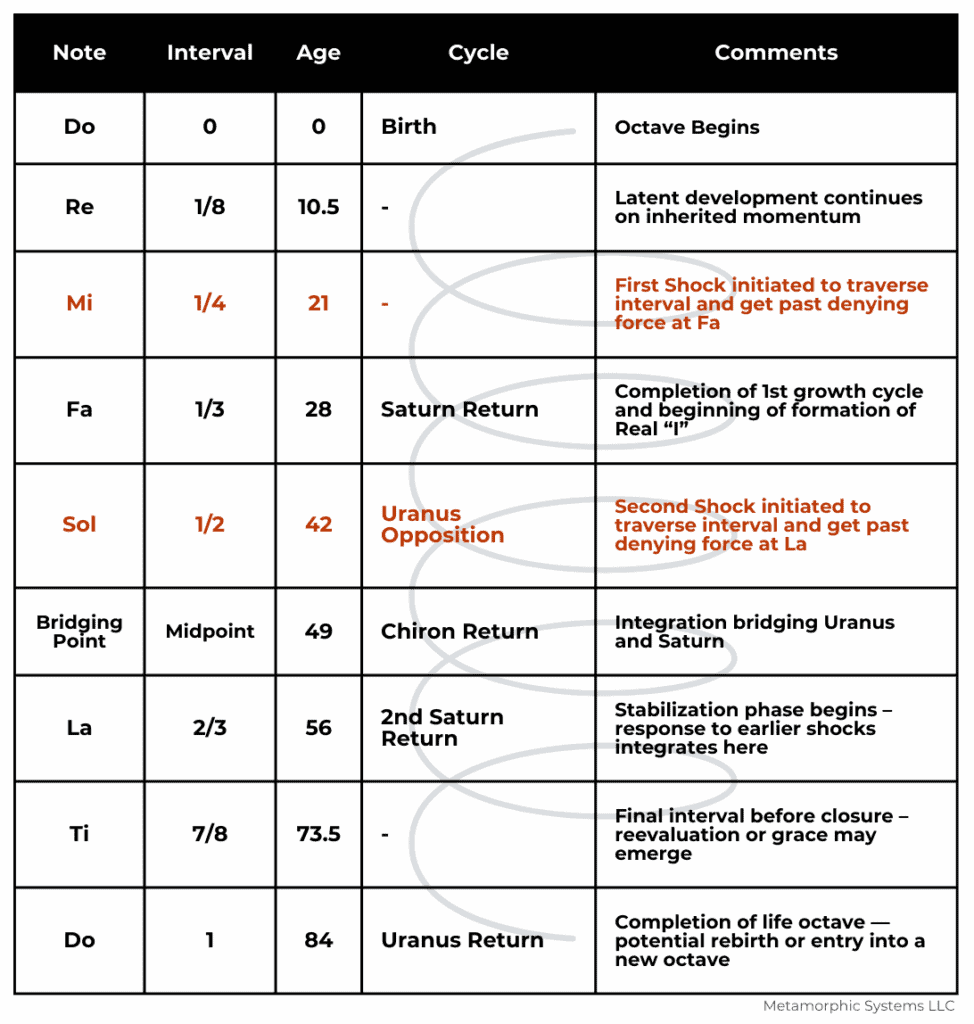
The Spiral Path of the Real “I”
Rodney Collin viewed planetary cycles not as arbitrary markers of time but as structured opportunities for growth. Each major cycle — Saturn, Uranus, Chiron — revisits familiar themes from a higher turn of the spiral, offering the possibility of progress rather than repetition. Saturn demands accountability, Uranus disrupts stagnation, and Chiron integrates unresolved material. Like the universe, human life unfolds in a harmonized structure. Each planetary cycle offers both challenge and invitation.
Exploring these laws and cosmic structures reveals that our major life events — including challenges, crises, and turning points — are not isolated occurrences. They are part of a lawful developmental process that begins at birth and unfolds through rhythm and resonance. When viewed through this lens, what once felt random or unfair becomes recognizable as part of a greater octave that offers distinct opportunities for engagement and transformation. This understanding helps us shift from reacting to life’s events to consciously participating in their deeper purpose.
When we recognize that life follows cosmic law — not by accident — we begin to listen for the intervals, feel the turning points, and surrender to the rhythm of becoming. In this, we shift from resisting life to participating in its unfolding—not by force, but through alignment, effort, and conscious engagement. And in that alignment, something essential emerges: not merely the completion of a life, but the shaping of a soul through awareness and resonance.
In the Fourth Way, the Real “I” is not a fixed identity, but a center of gravity — a stable presence that forms through repeated engagement with shocks and transitions. This parallels what Human Design calls the “True Self”: not a role or mask, but the outcome of living true to one’s nature, moment by moment. It arises gradually, as we learn to meet key intervals not reactively, but awake and present as ourselves.
Time and rhythm do not simply pass — they shape us. When we meet life’s intervals with presence, transformation becomes possible. The spiral path does not repeat; it evolves. The Real “I” and “True-Self” are not waiting at the end — they are cultivated in the movement itself.
Further Reading
For those interested in exploring the teachings and frameworks referenced throughout this article, the following texts provide rich, foundational insights:
- Russell A. Smith – Gurdjieff: Cosmic Secrets – A practical and mathematically grounded exposition of Gurdjieff’s Laws of Three and Seven, the Enneagram, and the Universal Cosmic Weave. Smith’s work clarifies the Fourth Way’s inner structure and reveals transformation’s vibrational architecture.
- Russell A. Smith – The Blueprint of Consciousness: An Accelerated Path to Awakening – A step-by-step walkthrough of the octave structure and shock mechanics, designed to lead readers into direct inner work through a highly ordered process.
- P.D. Ouspensky – In Search of the Miraculous – This book is a classic introduction to Gurdjieff’s teachings, as recorded by one of his most devoted students. It offers essential explanations of the Ray of Creation, the Octave, and the nature of human mechanicality.
- Rodney Collin – The Theory of Celestial Influence – A profound cosmological extension of the Fourth Way, exploring the relationships between planetary movements, human development, and the evolution of consciousness. A key source for understanding the spiral nature of time and the Real “I.”

